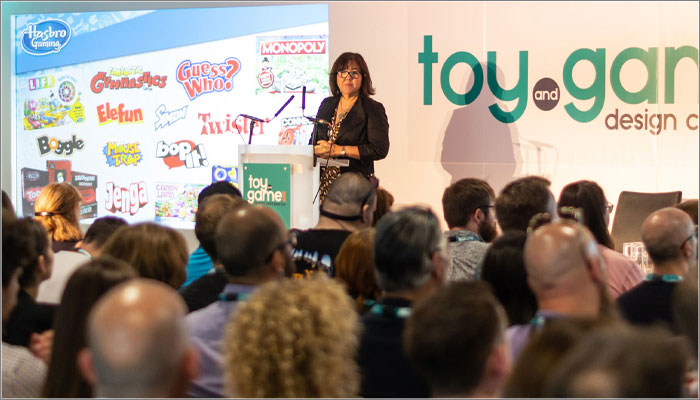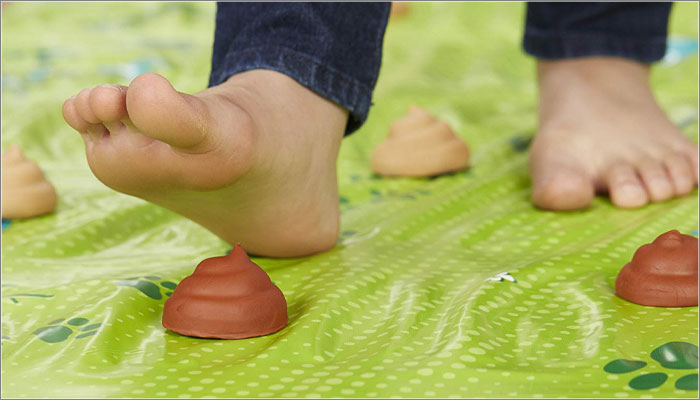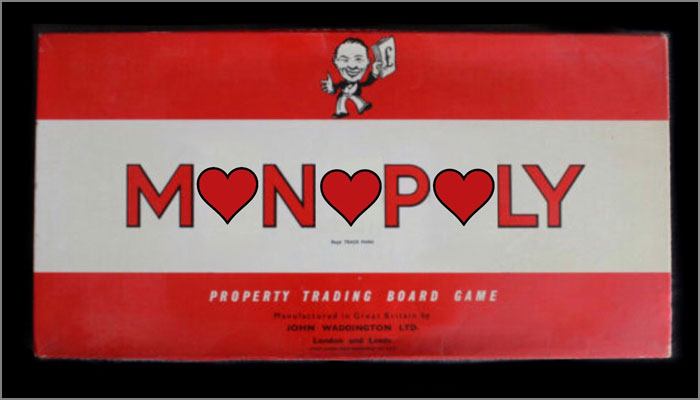Hasbro’s Tanya Thompson on videos, napkins… And how to pitch to her!

Tanya Thompson, Hasbro’s Director of Global Product Acquisition for Games, tells inventors how to give her a winning pitch…
Hi Tanya!If memory serves, you initially got into toys and games through looking for interesting ways to teach maths! I also know you’re interested in the work and puzzles of mathematician Martin Gardner. Tell us about that…
You’ve got a good memory! Before I came into the toy and game industry, I was a math teacher. I was always looking for ways to inspire my students. Martin Gardner was a brilliant recreational mathematics writer… He wrote the column Mathematical Games in Scientific American and introduced people like M.C. Escher to the world…
And how did you use his work?
I used his writings to inspire students! It got them playing with mathematics. I was thrilled later on to be invited to attend a conference based on his work called the Gathering for Gardner.

Oh, yes… Quite an extraordinary event, in celebration of an actual genius. Did you ever meet him?
Yes – I did meet him, and was honoured to befriend him about five years before he died. I’d visit him annually. Incidentally, my desire to play with math in my classroom led me to the toy and game industry!
Yes! During your talk at last year’s Play Creators Festival, you said you met Bill Ritchie of ThinkFun through teaching teachers to teach. In the same speech, you also advised people they didn’t need super-polished prototypes… And said not to show up with an idea sketched on a napkin! How would inventors know when enough is enough in this respect?
You just don’t want to break the bank on your prototype. It should be usable enough to demonstrate the idea, but there’s no need to spend a fortune creating a “final” product. It should be a proof of concept, but it doesn’t have to be professionally polished. Now you’ve likely heard stories of great successes like Bakugan which was pitched on a napkin. If you’ve never met with a company before, I wouldn’t recommend that you come prepared only with a napkin!

Because there’s no existing trust?
Exactly. Usually those kinds of “napkin” pitches are between people who have already built a relationship. I will say that I see over a thousand game concepts every year and you must make yours stand out. What’s most important is the game itself; the exciting new game play or game mechanism. So, show me a prototype that brings this to life!
And on that subject, how do you like to see ideas? By which I mean: when people pitch to you, is there a “best way”?
Videos are key. They should be a 30-second to two-minute sizzle video. The sizzle should highlight your concept’s best unique features. Show an overview of how to play and include great shots of the components. Be energetic and passionate, and make me excited about your game!
This is before seeing whatever kind of physical prototype there is?
Ideally! If I’m interested after the video, I may ask to see the prototype if there’s something I physically want to see. But if it’s straightforward, I may just ask you to send me your video which I’ll use internally to see if there’s interest.
You also talk about stacking the deck for pitches. What do you mean by that?
Yes – if you’re showing a prototype, don’t leave anything to chance – like shuffled decks or random dice rolls… Don’t leave it to chance that a six will come up, for example. You want to get to the best part quickly! So if your game has dice rolling, just say “So if you roll a six, this amazing thing happens!” Or if you’re showing a mechanism, make sure you get to the magic right away.

And when an inventor shows you a promising idea, what happens next? How do you, Hasbro and external partners start developing it?
If I’m interested in your idea, I first take in your materials like videos, photos and rule sets. I then pitch it to the leads of Hasbro Gaming. If they’re interested, we ask for a working, playable prototype. Then the design team play tests it to evaluate game play, theme, mechanics, packaging, costs, etc. And if they feel it has potential, they start envisioning how it could fit in our product lines.
You said there that you pitch the ideas to the leads of Hasbro Gaming… So, presumably, people need to understand that you have to champion products internally! What one thing can inventors do to make that easier for you?
Make good videos. Make good working prototypes. Give us time. If we request a prototype, once it arrives it typically takes us two to eight weeks to fully evaluate it. If we have interest after that, we then enter into a more formal agreement like an Option and then after that a Contract.
Brilliant. It’s so helpful when it’s all broken down step by step like this. So! I know you’re always on the lookout for games with a hook… But what kind of thing qualifies as a hook? And what pointers you can give in that regard? For example, might the hook be a trend, say, or a highly-visual moment?
Hasbro games tend to have mass appeal. Think of the very busy mom quickly walking the aisles of a big store, maybe with kids in tow, who’s looking for something to entertain her family. How does a game stand out? What’s the hook that’s going to grab her attention? Is it an easy-to-get theme that she understands instantly? Is it a magical mechanism that she thinks will delight her family?
Also, is it something completely new and innovative that she’s never seen before? Is it based on a topic she was just reading about in the news, or her kids were talking about after school? Is it all these things? When I’m looking at games, I’m thinking of all these things for players aged preschool to adult. I’ll also add, since I see so many new concepts every year and I’m a passionate gamer myself, what I love is when your game surprises me with something different!
Oh, wonderful! I love those empathy questions… And making all that tangible, can you walk us through an idea that was pitched to you in a way that ticked your boxes?
Don’t Step in It by Don Ullman and Bob Driscoll. Don’t Step in It is a scenario where players are trying not to step in Play-Doh poop piles. Everyone can relate to walking through the park and trying to avoid this happening.

Right! There’s really nothing to explain in the theme?!
Exactly; it’s an easy get. Also, it breaks frame as Play-Doh is usually played with your hands, not your feet, so that was something different. It’s also based in humour and is very light-hearted… And these days people are looking for relief from the seriousness of the world around them.
The inventor Sally Jacobs sums up a popular play pattern in a neat way… She describes very ‘toyetic’ games as going “push, push pop”! To some extent, Hasbro has exemplified that play pattern in the recent past. Is that still a focus?
I love Sally! Hasbro always looks for games that have those exciting moments, what we call TV moments. What’s changing is that we’re not only looking at toyetic games, which tend to be for preschoolers, ages 4+, but also games with TV moments that are skill & action games for kids ages 8-12. Also, party or light strategy games for families, age 8+.
Also, I’m really curious… With the pace and intricacy of Monopoly, I often fear the worst when new inventors tell me they’ve got, “The next Monopoly!” Since Hasbro has the original Monopoly, is that a format you’d look to develop today?
Ha! Yeah, that’s a tell of a new inventor when they say, “I have the next Monopoly!” or “I have the next Rubik’s Cube!” Because not many concepts can live up to the success of those two. Regarding Monopoly, we’re fortunate to own the biggest game brand in the world. However, because there’s so much internal ideation and development being done on Monopoly every year, suggestions of themes aren’t something we’re looking for – Monopoly with Dogs, for example!

Damn! Another strike…
That said, we are looking for new and innovative features for Monopoly like new physical mechanisms, new technologies for use in physical components, and new game play mechanics.
Got it. Tanya, this has been terrifically straightforward; really insightful – thank you. Two more questions… First, if you were to write your autobiography, what would you call it?
Changing the World Through Play
Simple as that! Lovely… And finally, what’s the most interesting thing in your office or on your desk?
I have an Impossible Object made for me by Gary Foshee. It’s a glass bottle, the shape of a beer bottle, with a wooden post that goes vertically down the skinny neck of the bottle…
I love impossible objects; I’m all ears…
Well, at the end of the post – inside the bottle – is a screw that goes horizontally through it. And down in the bottle is my business card! So, one might ask themselves, how did that screw get screwed into the post and, how did that business card get flawlessly into the bottle? That’s why it’s called an Impossible Object! I love it because it’s a playful object with my name in it that reminds me to think differently!

Absolutely wonderful! Tanya, what a pleasure to tie in; it always is. I’m going to sign off with a Martin Gardner web address, but in the meantime, let me say thank you so much for your time. www.gathering4gardner.org
—-
To stay in the loop with the latest news, interviews and features from the world of toy and game design, sign up to our weekly newsletter here
























